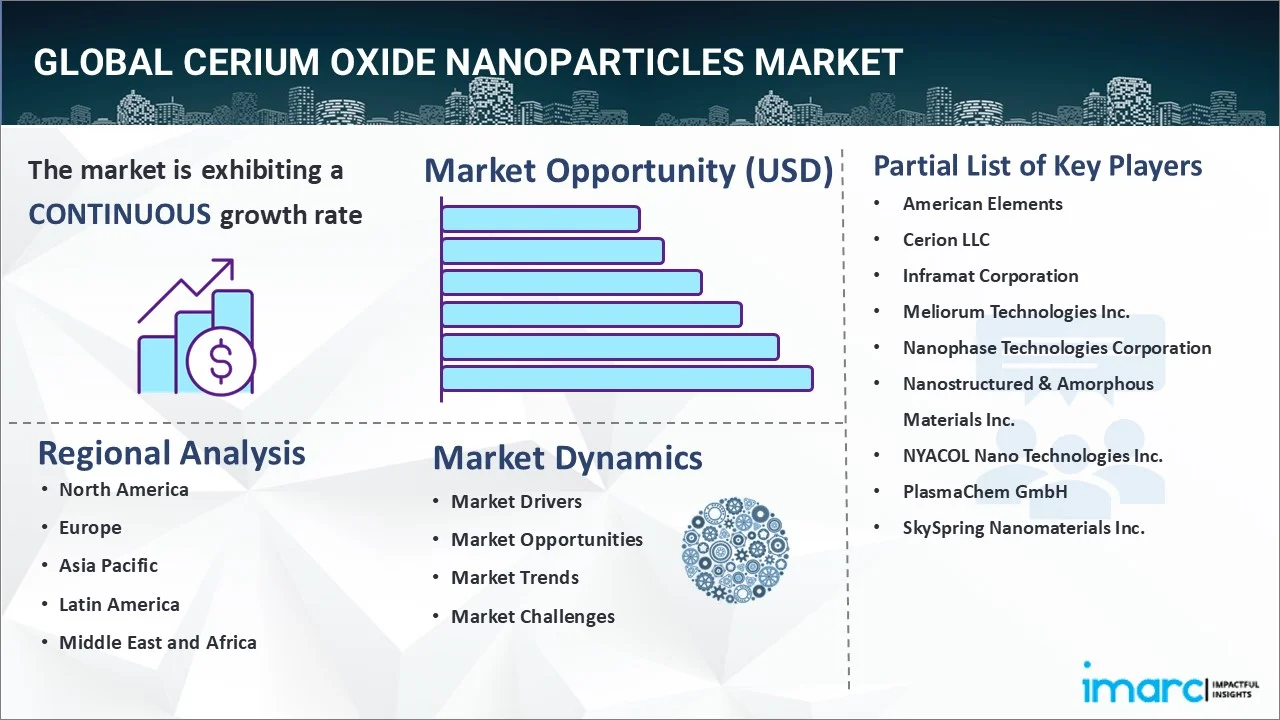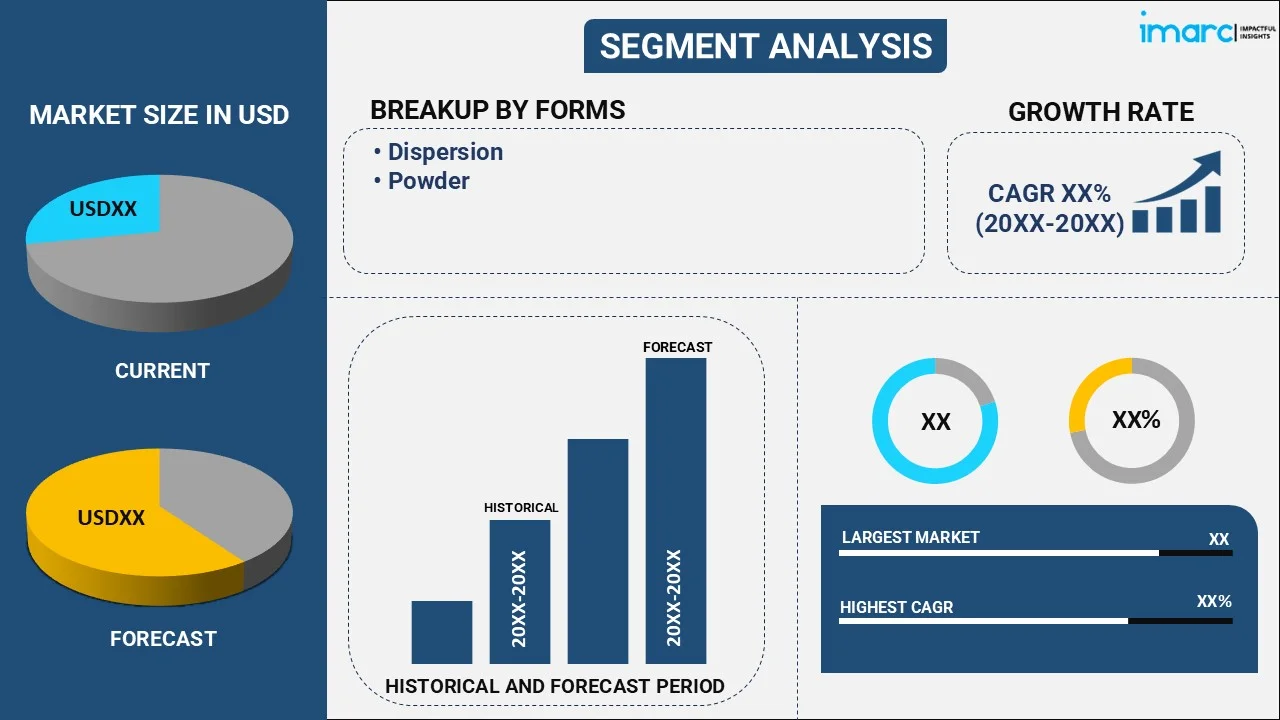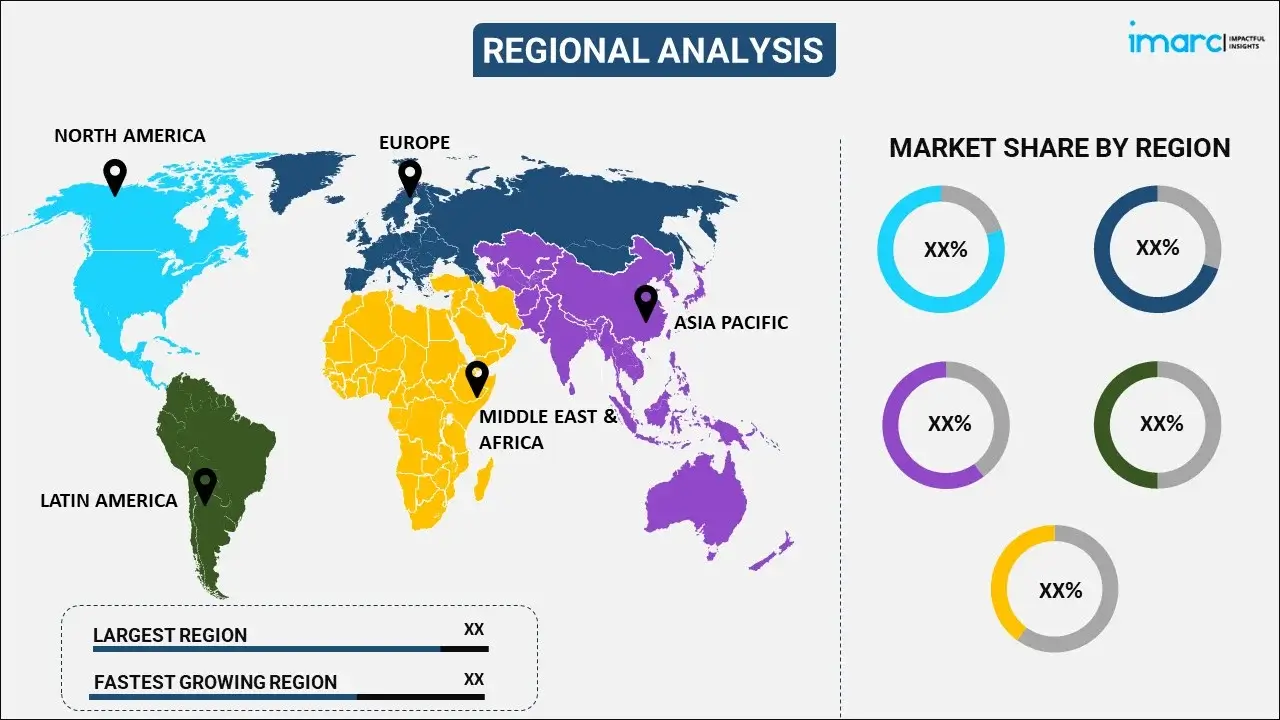
Cerium Oxide Nanoparticles Market Report by Form (Dispersion, Powder), Synthesis Method (Traditional Synthesis Methods, Green Synthesis Methods), Application (Energy Storage, Polishing Agent, Personal Care, Pharmaceuticals, and Others), and Region 2025-2033
Market Overview:
The global cerium oxide nanoparticles market size reached USD 1,092.8 Million in 2024. Looking forward, IMARC Group expects the market to reach USD 4,201.4 Million by 2033, exhibiting a growth rate (CAGR) of 15.33% during 2025-2033. Some of the factors driving the market growth include the rising product demand from the automotive industry, expanding renewable energy sector, advancements in the healthcare sector, and R&D activities in catalysis and water purification applications.
|
Report Attribute
|
Key Statistics
|
|---|---|
|
Base Year
|
2024 |
|
Forecast Years
|
2025-2033
|
|
Historical Years
|
2019-2024
|
|
Market Size in 2024
|
USD 1,092.8 Million |
|
Market Forecast in 2033
|
USD 4,201.4 Million |
| Market Growth Rate 2025-2033 | 15.33% |
Cerium oxide nanoparticles, also known as ceria nanoparticles or nanoceria, refer to tiny particles of cerium oxide with dimensions typically ranging from 1 to 100 nanometers. Cerium oxide, with the chemical formula CeO2, is a versatile and widely used compound in various industries. At the nanoscale, cerium oxide exhibits distinct properties and characteristics compared to its bulk form. Cerium oxide nanoparticles possess unique catalytic, optical, and electrical properties, making them valuable in several applications. Their high surface area and oxygen storage capacity make them excellent catalysts for various chemical reactions, including automotive catalysis and environmental remediation processes. Additionally, ceria nanoparticles demonstrate exceptional redox behavior, enabling their utilization in fuel cells, sensors, and energy storage systems.

One of the major factors driving the demand for cerium oxide nanoparticles represents the advancements in electronics and optics due to their unique electrical and optical properties. These nanoparticles are used in the production of conductive pastes, optical coatings, and sensors. With the rapid development of electronic devices, displays, and sensors, the demand for cerium oxide nanoparticles is expected to witness significant growth. In addition to this, the continuous research and development efforts to explore new applications and improve the properties of cerium oxide nanoparticles are driving their demand. Market players are investing in research and development activities to explore the potential uses of cerium oxide nanoparticles in fields such as environmental remediation, catalysis, and water purification, which, in turn, is creating a positive market outlook.
Cerium Oxide Nanoparticles Market Trends/Drivers:
Growing demand in the automotive industry
One of the primary drivers of the global demand for cerium oxide nanoparticles is the automotive industry. Stricter emission regulations imposed by governments worldwide have compelled automakers to invest in technologies that reduce harmful emissions. Cerium oxide nanoparticles are used in catalytic converters, which play a crucial role in reducing pollutants from vehicle exhaust gases. These nanoparticles act as catalysts, promoting the conversion of harmful gases like carbon monoxide, nitrogen oxides, and hydrocarbons into less harmful substances. The unique properties of cerium oxide nanoparticles, such as high oxygen storage capacity and redox behavior, make them effective in enhancing catalytic converter efficiency. As the automotive industry continues to expand, particularly in emerging economies, the demand for cerium oxide nanoparticles as a catalyst material is projected to grow significantly.
Increasing applications in energy storage
The global shift toward renewable energy sources and the need for efficient energy storage systems have fueled the demand for cerium oxide nanoparticles. As renewable energy generation increases, the demand for advanced battery technologies is growing. Cerium oxide nanoparticles are used in lithium-ion batteries to improve their performance and lifespan. These nanoparticles enhance the stability of battery materials, reduce side reactions, and improve the charge/discharge efficiency. Additionally, cerium oxide nanoparticles can mitigate issues like electrode degradation and capacity loss, thereby enhancing the overall energy storage capabilities of batteries. With the rising adoption of electric vehicles and the need for grid-scale energy storage solutions, the demand for cerium oxide nanoparticles in the energy storage sector is anticipated to witness substantial growth.
Growing interest in biomedical applications
Cerium oxide nanoparticles have garnered significant interest in the biomedical field due to their unique antioxidant properties. These nanoparticles have the ability to scavenge reactive oxygen species (ROS) and protect cells from oxidative stress. As a result, they hold great potential for applications in drug delivery systems, cancer treatment, and neurodegenerative disease therapy. In drug delivery, cerium oxide nanoparticles can act as carriers for targeted and controlled drug release, enhancing therapeutic outcomes. They have also demonstrated promising results in cancer treatment, where they can aid in the destruction of cancer cells and minimize damage to healthy tissues. Furthermore, research has shown that cerium oxide nanoparticles possess neuroprotective properties and can potentially mitigate oxidative damage in neurodegenerative diseases such as Alzheimer's and Parkinson's. The increasing focus on healthcare advancements and the continuous exploration of nanomedicine applications have fueled the demand for cerium oxide nanoparticles in the biomedical sector.
Cerium Oxide Nanoparticles Industry Segmentation:
IMARC Group provides an analysis of the key trends in each segment of the global cerium oxide nanoparticles market report, along with forecasts at the global, regional, and country levels from 2025-2033. Our report has categorized the market based on form, synthesis method, and application.
Breakup by Form:

- Dispersion
- Powder
Dispersion represents the leading form
The report has provided a detailed breakup and analysis of the cerium oxide nanoparticles market based on the form. This includes dispersion and powder. According to the report, dispersion represented the largest segment.
Cerium oxide nanoparticles in the form of dispersions refer to a stable suspension of nanoparticles in a liquid medium. These dispersions offer advantages such as ease of handling, uniform distribution of nanoparticles, and compatibility with various applications. They are commonly used in industries such as automotive, electronics, and biomedical. Dispersion-based cerium oxide nanoparticles find applications in catalysts, coatings, polishing agents, fuel additives, and as an ingredient in various formulations. The dispersion form allows for precise control over the concentration and particle size, enabling tailored solutions for specific applications.
On the other hand, cerium oxide nanoparticles in the powder form refer to dry, fine particles of cerium oxide. This form is commonly used in applications where the nanoparticles need to be incorporated into solid materials or formulations. Cerium oxide nanopowders are employed in industries such as energy storage, optics, ceramics, and electronics.
Breakup by Synthesis Method:
- Traditional Synthesis Methods
- Green Synthesis Methods
A detailed breakup and analysis of the cerium oxide nanoparticles market based on the synthesis method has also been provided in the report. This includes traditional and green synthesis methods.
Traditional synthesis methods involve well-established and widely-used techniques for producing cerium oxide nanoparticles. These methods include precipitation, sol-gel, thermal decomposition, hydrothermal synthesis, and other chemical synthesis routes. Traditional synthesis methods often involve the use of organic solvents, chemical reagents, and high temperatures. They offer precise control over the particle size, morphology, and composition of the nanoparticles. These methods have been extensively studied and optimized, leading to consistent production and reliable quality of cerium oxide nanoparticles.
Green synthesis methods, also known as environmentally friendly or sustainable synthesis methods, involve the use of eco-friendly and renewable resources to produce cerium oxide nanoparticles. These methods aim to minimize the environmental impact and reduce the use of hazardous substances typically associated with traditional synthesis methods. Green synthesis methods may utilize biological agents such as bacteria, fungi, algae, or plant extracts as reducing and stabilizing agents for the synthesis process.
Breakup by Application:
- Energy Storage
- Polishing Agent
- Personal Care
- Pharmaceuticals
- Others
Energy storage applications dominate the market
The report has provided a detailed breakup and analysis of the cerium oxide nanoparticles market based on the application. This includes energy storage, polishing agent, personal care, pharmaceuticals, and others. According to the report, energy storage represented the largest segment.
In the energy storage segment, cerium oxide nanoparticles enhance the performance and longevity of batteries by improving their stability, charge/discharge efficiency, and cycle life. Cerium oxide nanoparticles are used in lithium-ion batteries, supercapacitors, and other energy storage devices, addressing the growing demand for efficient and reliable energy storage solutions in sectors such as automotive, renewable energy, and electronics.
Cerium oxide nanoparticles also find extensive use as polishing agents in industries such as optics, glass manufacturing, and precision engineering. The unique properties of these nanoparticles, including their high hardness, fine particle size, and chemical reactivity, enable them to achieve high-quality finishes and precise surface polishing. In addition to this, these nanoparticles are utilized in the personal care industry for various applications. They are incorporated into cosmetic formulations, skincare products, and sunscreen formulations due to their antioxidant properties and UV-absorbing capabilities.
Breakup by Region:

- North America
- United States
- Canada
- Asia-Pacific
- China
- Japan
- India
- South Korea
- Australia
- Indonesia
- Others
- Europe
- Germany
- France
- United Kingdom
- Italy
- Spain
- Russia
- Others
- Latin America
- Brazil
- Mexico
- Others
- Middle East and Africa
North America exhibits a clear dominance, accounting for the largest cerium oxide nanoparticles market share
The report has also provided a comprehensive analysis of all the major regional markets, which include North America (the United States and Canada); Asia Pacific (China, Japan, India, South Korea, Australia, Indonesia, and others); Europe (Germany, France, the United Kingdom, Italy, Spain, Russia, and others); Latin America (Brazil, Mexico, and others); and the Middle East and Africa.
North America is the leading market for cerium oxide nanoparticles since the region has a robust automotive industry. The stringent emission regulations in North America drive the demand for advanced catalyst materials, where cerium oxide nanoparticles play a crucial role in reducing harmful exhaust emissions. Additionally, North America exhibits strong growth in the energy storage sector, including electric vehicles and renewable energy technologies, which further boosts the demand for cerium oxide nanoparticles in lithium-ion batteries and other energy storage applications. Furthermore, the presence of well-established research institutions, technological advancements, and the increasing focus on nanotechnology research and development contribute to the market dominance of North America in the cerium oxide nanoparticles industry.
Competitive Landscape:
The key players in the cerium oxide nanoparticles market have been driving innovation through various strategies to enhance product performance and expand their market presence. One notable innovation is the development of surface functionalization techniques. These techniques involve modifying the surface properties of cerium oxide nanoparticles to improve their compatibility with specific applications, such as targeted drug delivery or enhancing catalytic activity. Furthermore, key players have been investing in research and development to explore novel applications of cerium oxide nanoparticles, such as in environmental remediation, water purification, and advanced electronics.
The report has provided a comprehensive analysis of the competitive landscape in the global cerium oxide nanoparticles market. Detailed profiles of all major companies have also been provided. Some of the key players in the market include:
- American Elements
- Cerion LLC
- Inframat Corporation
- Meliorum Technologies Inc.
- Nanophase Technologies Corporation
- Nanostructured & Amorphous Materials Inc.
- NYACOL Nano Technologies Inc.
- PlasmaChem GmbH
- SkySpring Nanomaterials Inc.
- Strem Chemicals Inc. (Ascensus Specialties LLC)
Cerium Oxide Nanoparticles Market Report Scope:
| Report Features | Details |
|---|---|
| Base Year of the Analysis | 2024 |
| Historical Period | 2019-2024 |
| Forecast Period | 2025-2033 |
| Units | Million USD |
| Scope of the Report | Exploration of Historical and Forecast Trends, Industry Catalysts and Challenges, Segment-Wise Historical and Predictive Market Assessment:
|
| Forms Covered | Dispersion, Powder |
| Synthesis Methods Covered | Traditional Synthesis Methods, Green Synthesis Methods |
| Applications Covered | Energy Storage, Polishing Agent, Personal Care, Pharmaceuticals, Others |
| Regions Covered | Asia Pacific, Europe, North America, Latin America, Middle East and Africa |
| Countries Covered | United States, Canada, Germany, France, United Kingdom, Italy, Spain, Russia, China, Japan, India, South Korea, Australia, Indonesia, Brazil, Mexico |
| Companies Covered | American Elements, Cerion LLC, Inframat Corporation, Meliorum Technologies Inc., Nanophase Technologies Corporation, Nanostructured & Amorphous Materials Inc., NYACOL Nano Technologies Inc., PlasmaChem GmbH, SkySpring Nanomaterials Inc. and Strem Chemicals Inc. (Ascensus Specialties LLC) |
| Customization Scope | 10% Free Customization |
| Post-Sale Analyst Support | 10-12 Weeks |
| Delivery Format | PDF and Excel through Email (We can also provide the editable version of the report in PPT/Word format on special request) |
Key Benefits for Stakeholders:
- IMARC’s report offers a comprehensive quantitative analysis of various market segments, historical and current market trends, market forecasts, and dynamics of the cerium oxide nanoparticles market from 2019-2033.
- The research study provides the latest information on the market drivers, challenges, and opportunities in the global cerium oxide nanoparticles market.
- The study maps the leading, as well as the fastest-growing, regional markets. It further enables stakeholders to identify the key country-level markets within each region.
- Porter's five forces analysis assist stakeholders in assessing the impact of new entrants, competitive rivalry, supplier power, buyer power, and the threat of substitution. It helps stakeholders to analyze the level of competition within the cerium oxide nanoparticles industry and its attractiveness.
- Competitive landscape allows stakeholders to understand their competitive environment and provides an insight into the current positions of key players in the market.
Key Questions Answered in This Report
The global cerium oxide nanoparticles market was valued at USD 1,092.8 Million in 2024.
We expect the global cerium oxide nanoparticles market to exhibit a CAGR of 15.33% during 2025-2033.
The growing utilization of cerium oxide nanoparticles in corrosion protection, fuel oxidation catalysis, and automotive exhaust treatment, is primarily driving the global cerium oxide nanoparticles market.
The sudden outbreak of the COVID-19 pandemic had led to the implementation of stringent lockdown regulations across several nations resulting in temporary closure of numerous end-use industries for cerium oxide nanoparticles.
Based on the form, the global cerium oxide nanoparticles market has been segmented into dispersion and powder. Currently, dispersion represents the largest market share.
Based on the application, the global cerium oxide nanoparticles market can be bifurcated into energy storage, polishing agent, personal care, pharmaceuticals, and others. Among these, the energy storage sector currently accounts for the majority of the total market share.
On a regional level, the market has been classified into North America, Europe, Asia-Pacific, Middle East and Africa, and Latin America, where North America currently dominates the global market.
Some of the major players in the global cerium oxide nanoparticles market include American Elements, Cerion LLC, Inframat Corporation, Meliorum Technologies Inc., Nanophase Technologies Corporation, Nanostructured & Amorphous Materials Inc., NYACOL Nano Technologies Inc., PlasmaChem GmbH, SkySpring Nanomaterials Inc., and Strem Chemicals Inc. (Ascensus Specialties LLC).
Need more help?
- Speak to our experienced analysts for insights on the current market scenarios.
- Include additional segments and countries to customize the report as per your requirement.
- Gain an unparalleled competitive advantage in your domain by understanding how to utilize the report and positively impacting your operations and revenue.
- For further assistance, please connect with our analysts.
 Inquire Before Buying
Inquire Before Buying
 Speak to an Analyst
Speak to an Analyst
 Request Brochure
Request Brochure
 Request Customization
Request Customization




.webp)




.webp)












